Supercluster - Study guides, Class notes & Summaries
Looking for the best study guides, study notes and summaries about Supercluster? On this page you'll find 58 study documents about Supercluster.
Page 3 out of 58 results
Sort by
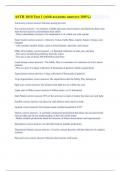
-
ASTR 1010 Test 1 (with accurate answers 100%)
- Exam (elaborations) • 11 pages • 2023
-
Available in package deal
-
- $11.29
- + learn more
Astronomy correct answers Patterns among the stars Sun correct answers - An ordinary, middle-aged star, more massive and luminous than some stars but less massive and luminous than others - Only extraordinary because of its importance to us within our solar system Solar System correct answers - Mercury, Venus, Earth, Mars, Jupiter, Saturn, Uranus, and Neptune - Also contains smaller bodies, such as dwarf planets, asteriods, and comets Milky Way Galaxy correct answers - A flattened col...
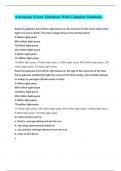
-
Astronomy Exam Questions With Complete Solutions.
- Exam (elaborations) • 17 pages • 2023
-
Available in package deal
-
- $7.99
- + learn more
Astronomy Exam Questions With Complete Solutions. Rank the galaxies from left to right based on the amount of time it has taken their light to travel to Earth, from the longest time to the shortest time: 5 billion light-years 800 million light-years 10 billion light-years 230 million light-years 2 billion light-years 70 million light-years 10 billion light years, 5 billion light years, 2 billion light years, 800 million light years, 230 million light years, 70 million light years R...
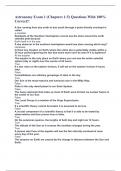
-
Astronomy Exam 1 (Chapters 1-5) Questions With 100% Correct!!
- Exam (elaborations) • 7 pages • 2023
-
- $10.99
- + learn more
Astronomy Exam 1 (Chapters 1-5) Questions With 100% Correct!! A line running from due north to due south through a point directly overhead is called a meridian Residents of the Southern Hemisphere cannot see the stars around the north celestial pole because Earth itself is in the way. A sky observer in the southern hemisphere would see stars moving which way? clockwise Is there any location on Earth where the entire sky is potentially visible within a 24 hour period (ignoring the fact t...
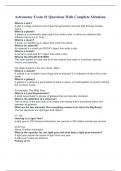
-
Astronomy Exam #1 Questions With Complete Solutions.
- Exam (elaborations) • 10 pages • 2024
-
- $13.98
- + learn more
Astronomy Exam #1 Questions With Complete Solutions. What is a star? A star is a large luminous ball of gas that generates heat and light through nuclear fusion. What is a planet? A planet is a moderately large object that orbits a star. It shines by reflected light. Planets may be icy or rocky What is a moon? A moon (or satellite) is an object that orbits the planet. What is an asteroid? An asteroid is a small and ROCKY object that orbits a star. What is a comet? A comet is small a...
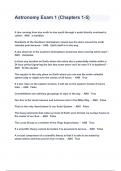
-
Astronomy Exam 1 (Chapters 1-5) Exam Questions And Answers
- Exam (elaborations) • 10 pages • 2023
- Available in package deal
-
- $12.99
- + learn more
Astronomy Exam 1 (Chapters 1-5) Exam Questions And Answers A line running from due north to due south through a point directly overhead is called - ANS a meridian Residents of the Southern Hemisphere cannot see the stars around the north celestial pole because - ANS Earth itself is in the way. A sky observer in the southern hemisphere would see stars moving which way? - ANS clockwise Is there any location on Earth where the entire sky is potentially visible within a 24 hour...

-
Test Bank For 21st Century Astronomy The Solar System Fifth Edition By Kay -Palen
- Exam (elaborations) • 1105 pages • 2023
-
Available in package deal
-
- $32.87
- + learn more
Chapter 1: Thinking Like an Astronomer LEARNING OBJECTIVES 1.1 Earth Occupies a Small Place in the Universe Define the bold-faced vocabulary terms within the chapter. Multiple Choice: 1, 9, 14, 21, 29, 31, 36, 37, 40, 42, 43, 44 Short Answer: 11, 17, 18 List our cosmic address. Multiple Choice: 22 Short Answer: 5 Differentiate the various components of our cosmic address. Multiple Choice: 2, 6, 23 Short Answer: 1, 3 Relate the different sizes of, or the different distances between, the...
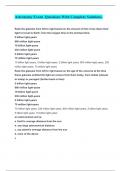
-
Astronomy Exam Questions With Complete Solutions.
- Exam (elaborations) • 17 pages • 2024
-
Available in package deal
-
- $7.19
- + learn more
Astronomy Exam Questions With Complete Solutions. Rank the galaxies from left to right based on the amount of time it has taken their light to travel to Earth, from the longest time to the shortest time: 5 billion light-years 800 million light-years 10 billion light-years 230 million light-years 2 billion light-years 70 million light-years 10 billion light years, 5 billion light years, 2 billion light years, 800 million light years, 230 million light years, 70 million light years R...
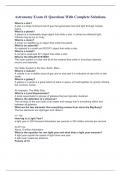
-
Astronomy Exam #1 Questions With Complete Solutions.
- Exam (elaborations) • 10 pages • 2024
-
- $10.49
- + learn more
Astronomy Exam #1 Questions With Complete Solutions. What is a star? A star is a large luminous ball of gas that generates heat and light through nuclear fusion. What is a planet? A planet is a moderately large object that orbits a star. It shines by reflected light. Planets may be icy or rocky What is a moon? A moon (or satellite) is an object that orbits the planet. What is an asteroid? An asteroid is a small and ROCKY object that orbits a star. What is a comet? A comet is small a...
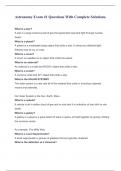
-
Astronomy Exam #1 Questions With Complete Solutions.
- Exam (elaborations) • 15 pages • 2024
-
Available in package deal
-
- $7.29
- + learn more
Astronomy Exam #1 Questions With Complete Solutions. What is a star? A star is a large luminous ball of gas that generates heat and light through nuclear fusion. What is a planet? A planet is a moderately large object that orbits a star. It shines by reflected light. Planets may be icy or rocky What is a moon? A moon (or satellite) is an object that orbits the planet. What is an asteroid? An asteroid is a small and ROCKY object that orbits a star. What is a comet? A comet is small...
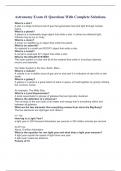
-
Astronomy Exam #1 Questions With Complete Solutions.
- Exam (elaborations) • 10 pages • 2024
-
- $13.49
- + learn more
Astronomy Exam #1 Questions With Complete Solutions. What is a star? A star is a large luminous ball of gas that generates heat and light through nuclear fusion. What is a planet? A planet is a moderately large object that orbits a star. It shines by reflected light. Planets may be icy or rocky What is a moon? A moon (or satellite) is an object that orbits the planet. What is an asteroid? An asteroid is a small and ROCKY object that orbits a star. What is a comet? A comet is small a...

How much did you already spend on Stuvia? Imagine there are plenty more of you out there paying for study notes, but this time YOU are the seller. Ka-ching! Discover all about earning on Stuvia


